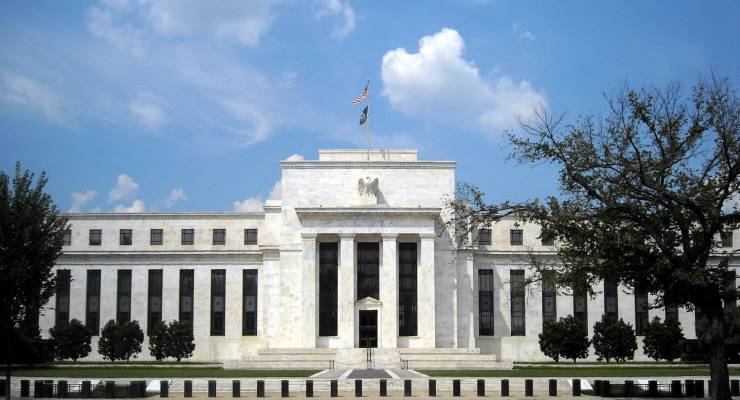
The rapidly gathering impact from the coronavirus pandemic on the US economy has forced the US Federal Reserve into its most dramatic intervention ever.
On late Sunday afternoon US time, the Fed slashed its key interest rate by 1.25% to the zero to 0.25% range (which is in effect zero), revealed its biggest ever program of quantitative easing of at least US$700 billion, and promised more action if needed.
The move is aimed at easing growing pressures in US financial markets from the damage inflicted by the virus on the US and global economies, and comes just days after the Fed promised to inject up to US$1.5 trillion of liquidity to ease conditions, and a March 3 interest rate cut of 0.5%.
The actions are the largest single day set of moves the US central bank had ever taken, exceeding anything during the 2008 global financial crisis.
“The coronavirus outbreak has harmed communities and disrupted economic activity in many countries, including the United States,” the Fed said in its statement. “The Federal Reserve is prepared to use its full range of tools to support the flow of credit to households and businesses and thereby promote its maximum employment and price stability goals.”
It also slashed the rate of emergency lending at the discount window for banks by 125 bps to 0.25%, and lengthened the term of loans to 90 days. Along with the rates, reserve requirements at banks were eased, and the Fed said it would work with foreign banks to enhance dollar liquidity.
Australia’s Council of Financial Regulators, which includes the Reserve Bank (RBA), the Australian Prudential Regulation Authority (APRA), the Australian Securities and Investments Commission (ASIC) and Treasury, announced this morning that the Reserve Bank “will be conducting one-month and three-month repurchase (repo) operations until further notice. In addition it will conduct repo operations of six-months maturity or longer at least weekly, as long as market conditions warrant.”
Repos are used every day by the Reserve Bank in its money market operations — the RBA buys bonds or high quality assets such as home mortgages from banks for a discount, paying 85-90% of face value of the security to give the seller cash for a period of time. Usually it is one or two days, sometimes a week, rarely a month. Today’s announcement means the RBA will be funding the financial system up to mid-June at least, reassuring financial markets that there will be enough money to finance transactions. This is separate from quantitative easing of the kind the Fed announced and which the Reserve Bank may yet pursue here.
The Council also announced ASIC and APRA will be prepared for waive regulatory requirements to minimise disruption and facilitate any quick fund raising by a listed company, and said it will be meeting with major lenders “to discuss how they can best support households and businesses through this challenging period”.
Separately, ASIC has imposed a remarkable crackdown on high-speed traders who have been blamed for much of the increased volatility in the Australian Securities Exchange (ASX) in recent days. In a statement issued this morning, ASIC made clear, without directly mentioning them, that it had taken aim at automated stock trading operators and high-speed speculators who use computer programs and algorithms to buy and sell shares rapidly to earn profits from small pricing differences.
They will be required to cut their daily volumes 25% from the record levels seen on Friday, when the ASX saw an 8% plunge in early trading and then a 12% rebound to close up more than 4%. ASIC said the “exponential increases” in trade has the potential to cause back office problems with brokers and investment banks. This is the first time the regulator has ordered high-speed traders to cut their activities and may be the first such limitation globally.
The Reserve Bank of New Zealand this morning also moved to slash its key rate to a new low of 0.25%, from 1%, and promise a program of bond buying if need be.
The unprecedented nature of the central bank and regulatory moves suggests monetary authorities are desperate to head off damage to financial systems from the growing economic crisis caused by the virus. Damage to banks and global lending systems may persist far longer than the immediate problems caused by the spread of coronavirus, limiting the capacity of economies to bounce back once the health crisis is over.
Despite the efforts of regulators, investors remained rattled this morning: the ASX200 was down 5.2% at deadline.









Now The Fed has no powder remaining in the barrel. Smart?
The thing isn’t a bazooka, it’s not even a kids pop-gun.
The neoliberal psychopaths and their bankrupt intellectual support group the Samuelson economists have told us that the Fed’s control of interest rates is only there to control the money supply and therefore inflation. Control of interest rates had had no effect on inflation; if it had, inflation would be running at 18% given the chronic low interest rates over the past twenty years. What the low interest rates have done and will continue to do is to support speculative trading by the vampire squids at Goldman Sachs and all the other entities like them.
Quantitative easing is just the same. The people who really need the money never get it because it is channeled through and then siphoned off by Wall Street to pay the upper rentier class who run and own the banks.
The Fed ‘s role is not to protect the US economy, it’s not to facilitate a moral and equitable economy, it’s job is to protect the interests of the rich financial sector.
The Australian Fed is better, but not by much.
If I hold this wet lettuce in front of my face, will that save me from the oncoming tsunami?
“the ASX200 was down 5.2% at deadline”
And 9.4 per cent by day’s end.